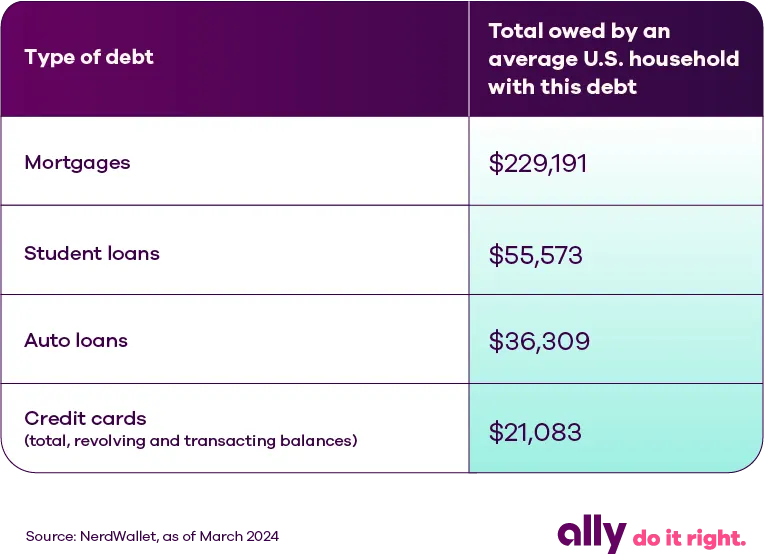Sizing up on homes for growing families, purchasing child care supplies and paying for schooling and after-school activities can quickly push parents into debt — especially when all that spending is done on top of regular expenses like groceries and housing. Let’s take a look at some common household debts for parents and how to handle not just the numbers, but the stress that can come with them.
Average debt by households
If you’re struggling with debt, you’re not alone. But how does U.S. debt break down by individual households?

Parents, in particular, are feeling the squeeze when it comes to spending. In a 2024 survey, 19% of parents said they went into debt to pay for child care last year. And credit card balances of those with children are as much as 26% above average.
It can be challenging to manage debt as a parent, but consider these steps to help you take back control.
Read more: Automated tools like spending and savings buckets can help you pay down debts.
Good vs. bad debt
Consider dividing what you owe into “good debt” and “bad debt.” Good debt is often seen as a side effect of pursuing a greater life or financial goal, like student loan debt or a mortgage.
Bad debts, on the other hand, may be the result of living beyond your financial means. This debt also tends to carry higher interest rates and penalties — and can indicate that your financial habits have some room for improvement, which may help you address debt moving forward.
Viewing your debt this way can help you determine what new debt to take on (if any) and which existing debt to pay off first.
How to start paying off debt
Acknowledging your debt is an important first step — and creating a payoff plan is a helpful second one. By prioritizing which debts to eliminate first, you can focus on freeing yourself of high-interest debts.
One popular approach to eliminating debt is the snowball method, which starts with paying off your smallest balance and moving onto the next smallest from there.
Assemble your tools
Everyone’s situation is unique, and tools like our debt-payoff quiz and the Economic Policy Institute’s Family Budget Calculator can help you get started on a strategy that works best for you. Ally Bank’s Spending Account also includes automated tools like spending buckets to help you stay on track.
Consider consolidating or refinancing
Initiating a balance transfer or a refinance may help make your debt more manageable. As part of a comprehensive plan, they could help make your debt easier to pay off.
Acknowledging your debt is an important first step — and creating a payoff plan is a helpful second one.
Factors to consider before borrowing money
Parents are often confronted with expenses that aren’t in the budget, whether it’s an emergency room visit, school supplies or summer camp fees. When combined with the basic costs of raising a child, it can be tempting to put surprise costs on a credit card or use a buy-now, pay later program.
These charges can quickly contribute to worsening your household debt. Consider whether you have room in your budget to allocate to urgent expenses. If not, you may need to readjust or build an emergency fund so you have room to cover surprise charges in the future.
If a purchase requires you to take on debt, ask yourself:
Is this purchase urgent, or can I wait until I have more cash on-hand?
Is this specific purchase necessary, or is a more affordable option available?
What financing options are available to me, and which have the lowest APR?
Is the long-term benefit of this expense worth the debt it will create?
Answering these questions can help guide you toward making spending decisions more responsibly.
Calculate your debt-to-income ratio
Keeping tabs on your debt-to-income ratio can also help guide your debt decision making. This is a measure of all your mandatory monthly debt payments divided by your monthly income before taxes and other deductions. This number can help you understand whether new debt may be too much.



